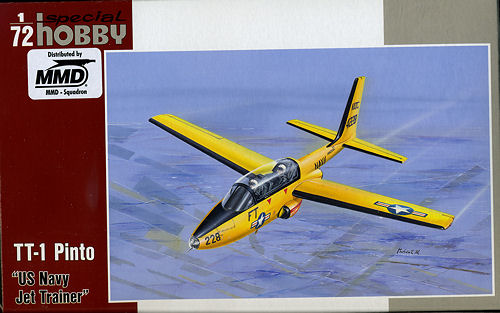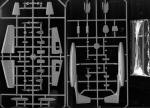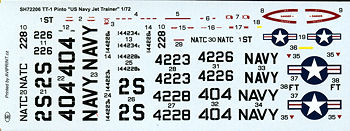
Special Hobby 1/72 TT-1 Pinto
| KIT #: | SH 72206 |
| PRICE: | $22.50 SRP |
| DECALS: | Four options |
| REVIEWER: | Scott Van Aken |
| NOTES: | Short run kit |

| HISTORY |
The Temco Model 51 had been initially proposed to the US Air Force in response to an Air Force competition for a jet-powered primary trainer, which was won by the Cessna T-37 Tweet. The concept behind the Model 51 was an attempt to provide primary training in a jet-powered aircraft. The official name for the Model 51 was the Pinto.
The Pinto was a mid-wing, tricycle landing gear trainer with an enclosed cockpit powered by a single Continental Motors J69-T-9 (license-built Turbomeca Marboré) jet engine. The aircraft carried no armament.
The TT-1s were equipped with many of the same features found in operational jets, including ejection seats, liquid oxygen equipment, speed brakes, along with typical flight controls and instrument panels. Although the flight characteristics were considered good, the "wave off" capability was rated marginal due to being slightly underpowered.
After its first flight in 1956, the prototype was sent to the Naval Air Test Center (NATC) Patuxent River to be evaluated alongside the Beech Model 73 Jet Mentor. Fourteen of the aircraft, designated TT-1, were produced between 1955 and 1957.
In 1959, these aircraft served in the Air Training Command at Pensacola, Florida and used in a training program demonstration testing the feasibility of using a jet-powered trainer for primary flight training.
In March 1959, Aviation Cadet E. R. Clark soloed in a TT-1, the first student in Naval Aviation history to solo a jet without previous experience in propeller aircraft. By the end of 1960, TT-1s were phased out of operations in the naval training command and sold as surplus.
| THE KIT |
 It is nice that Special Hobby decided to kit this aircraft. While not all that well known, it has not been well served by kit makers, the only other injected plastic kit being done by Aurora way back in the 1960s. It is obvious when looking at the two injected sprues that this is going to be used for another version as there are several parts not applicable to this boxing. Indeed, a civil super Pinto is boxed that will use the tip tanks, weapons pylon and different intake to name a couple of things.
It is nice that Special Hobby decided to kit this aircraft. While not all that well known, it has not been well served by kit makers, the only other injected plastic kit being done by Aurora way back in the 1960s. It is obvious when looking at the two injected sprues that this is going to be used for another version as there are several parts not applicable to this boxing. Indeed, a civil super Pinto is boxed that will use the tip tanks, weapons pylon and different intake to name a couple of things.  Instructions are well done, as usual with Special Hobby/MPM/Azur, and offer color information using Gunze paints. There are four markings options, all of them in Trainer Yellow with Black anti-glare nose panels. A full color painting and markings guide is on the back of the box with four options. One is the box art plane with NATC in Flight Test or Service Test markings from 1958. Next is the first of the fourteen production aircraft with just base markings from 1957. The third option is one of the service aircraft based at Saufley Field in 1960. The final option is another NATC plane from March 1958. This is the scheme with which one would use the optional nose gear. Decals are superbly printed by Aviprint and should work very well.
Instructions are well done, as usual with Special Hobby/MPM/Azur, and offer color information using Gunze paints. There are four markings options, all of them in Trainer Yellow with Black anti-glare nose panels. A full color painting and markings guide is on the back of the box with four options. One is the box art plane with NATC in Flight Test or Service Test markings from 1958. Next is the first of the fourteen production aircraft with just base markings from 1957. The third option is one of the service aircraft based at Saufley Field in 1960. The final option is another NATC plane from March 1958. This is the scheme with which one would use the optional nose gear. Decals are superbly printed by Aviprint and should work very well. | CONCLUSIONS |
I am quite pleased to see this kitted as I am drawn to kits like this. Small it will be and I should add that though no nose weight is suggested in the instructions, it might not be a bad idea to add some. It is a rather basic kit and would be perfect for those who want to dabble in short run.
| REFERENCES |
http://en.wikipedia.org/wiki/Temco_TT_Pinto
June 2012
If you would like your product reviewed fairly and fairly quickly, please contact the editor or see other details in the